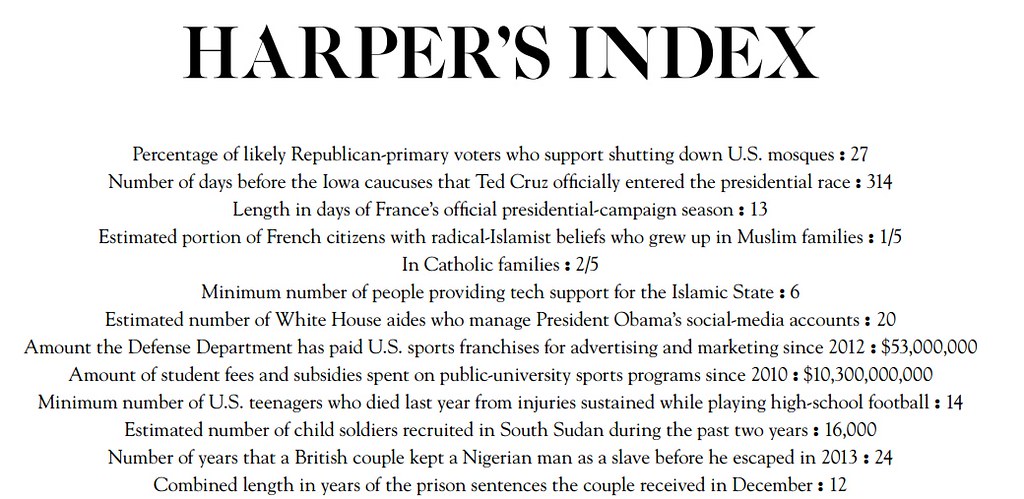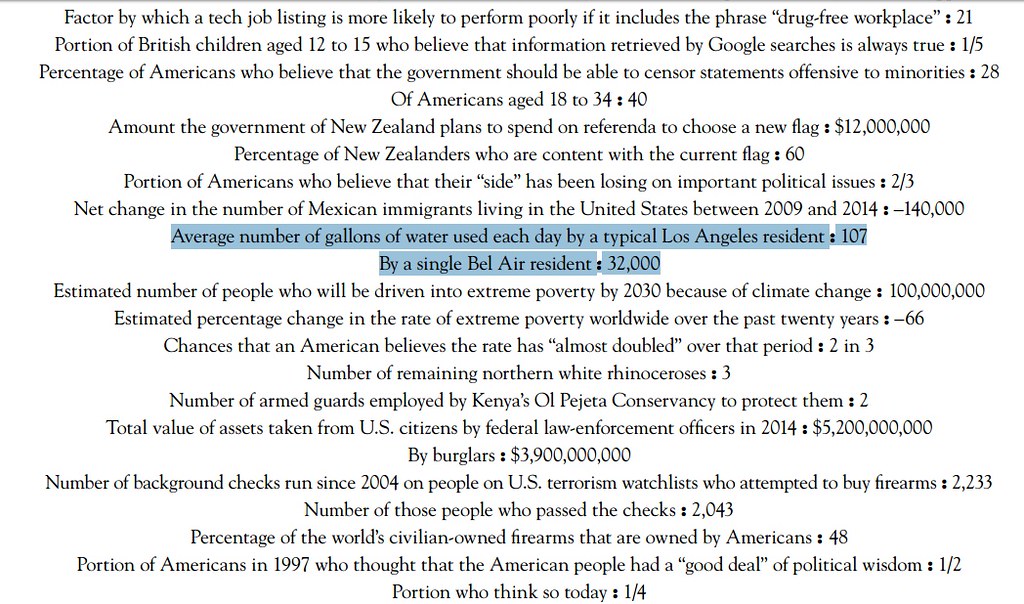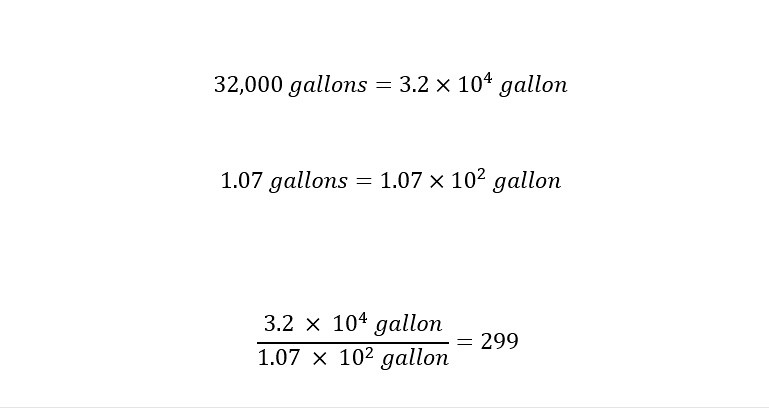Different People Have Different Uses?
Different people have different water needs throughout the Southern California region. If you are an owner of a nursery, then your water usage will be quite different from an owner of a two bedroom condominium unit. But those are two very different uses of water within the same geographical region. What struck my eye was something more similar in nature (in usage). Meaning, two statistics that were orders of magnitude different within the same region. Furthermore, both are based on "average users." Let me cut to the chase and show you an astounding set of data (two data points).
Every month, Harper's Magazine publishes a monthly magazine in which is included a section titled "Harper's Index". Below is a picture of the top of the page along with a few statistics:
Looking over the different statistics, one cannot help but wonder the source and method by which the statistics were calculated. At least, that is what I think when I read through the various 'stats' each month with curiosity. On the page for February, which is shown above, further down, there are two statistics which were generated by the Los Angeles Department of Water and Power. I cut up the image and provided the two statistics below regarding water usage in Los Angeles:
Upon closer inspection, two are highlighted on the image. The first reads -- "Average number of gallons of water used each day by a typical Los Angeles resident: 107". Whereas the second reads -- "By a single Bel Air resident: 32,000" -- WOW! When I first read this (which was late at night), I had to get up and take the dog out for a little walk before returning to read over the statistics again. Upon re-reading the page, sure enough -- the typical Los Angeles resident uses 107 gallons of water each day. Whereas the typical Bel Air resident uses 32,000 gallons in comparison. WOW.
I had to stop and think -- my mind was racing trying to come up with ideas as to how a person would use 32,000 gallons per day of water. Of course, remember that these figures are averaged out which do not make them any better. I immediately thought about writing a short post with a calculation to compare these two values. I calculated the ratio of the two numbers (32,000 and 107) to derive a factor to differentiate the two. Here is my result below:
And the results say that the typical Bel Air resident uses 299 times the amount of the typical Los Angeles resident. WOW. There exists no excuse to have such a large difference in usage -- especially during a time of a so-called drought. I would hope that Mayor Garcetti would inquire into this difference and justify the difference to the public. In the spirit equity, he could demand that the Department of Water and Power investigate and take action to correct for this disparity. This is absolutely ridiculous.
Mayor Garcetti has been pushing a campaign called "Save The Drop". A number of useful tools (such as a water calculator) are on the webpage along with a "Q&A" about the drought in California. Additionally, next to the 'online form' to sign up for 'updates' on the campaign, a 'box' appears with a title "Donate" with the following description:
Visit the Mayor's Fund for Los Angeles to give to the campaign. Your donation will go towards spreading awareness.
Pertaining to conserving water the Mayor's Fund Los Angeles states the following -- taken from an article in the Chronicle of Philanthropy:

Exactly what these measures to reduce water usage in the drought-stricken region might be remains to be seen. More leadership followed by action (implementing fines to violators, coming down hard on LADWP for action, and follow through) would be a great place to start. The evidence of need for change is very apparent. The extend of change depends on his actions along with those under his authority.
I promised a short blog post. With that, I will leave you with the following question:
How much water do you use in a single day?
I would hope by asking the question, you will inclined to take a moment to pause and think critically about your daily use of water. Further, in formulating your answer, I would hope that problematic areas of use (over use) might arise. After formulating your answer, you might even consider implementing solutions that might reduce your usage of this precious resource -- which occupies the news here in California on a weekly basis.
Think about Flint Michigan and their water issues. What would happen if the water was shut off in your neighborhood due to a problem of contamination? How often do you think about your daily water usage? Most of us take for granted the ability to turn on the faucet at any hour of the day and receive water that is drinkable.
Lets all try to conserve a little more. And by my stating 'Lets all...' -- I mean Bel Air -- water hogs. Have a great afternoon.
How much water do you use in a single day?
I would hope by asking the question, you will inclined to take a moment to pause and think critically about your daily use of water. Further, in formulating your answer, I would hope that problematic areas of use (over use) might arise. After formulating your answer, you might even consider implementing solutions that might reduce your usage of this precious resource -- which occupies the news here in California on a weekly basis.
Think about Flint Michigan and their water issues. What would happen if the water was shut off in your neighborhood due to a problem of contamination? How often do you think about your daily water usage? Most of us take for granted the ability to turn on the faucet at any hour of the day and receive water that is drinkable.
Lets all try to conserve a little more. And by my stating 'Lets all...' -- I mean Bel Air -- water hogs. Have a great afternoon.



No comments:
Post a Comment